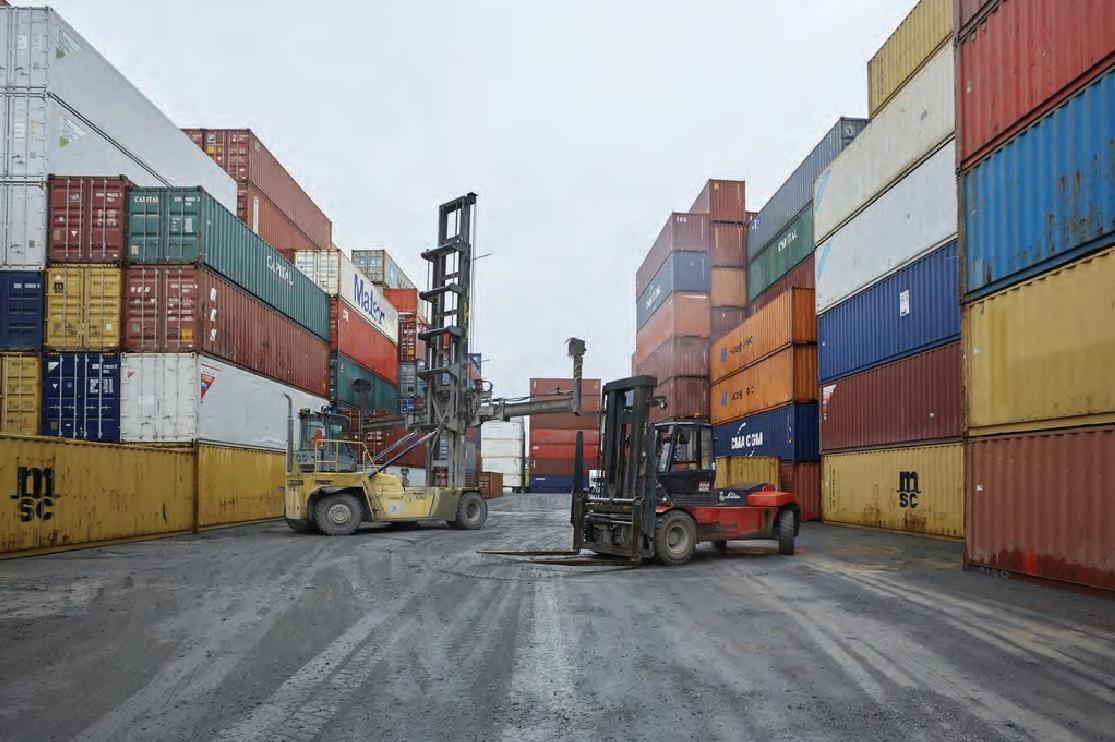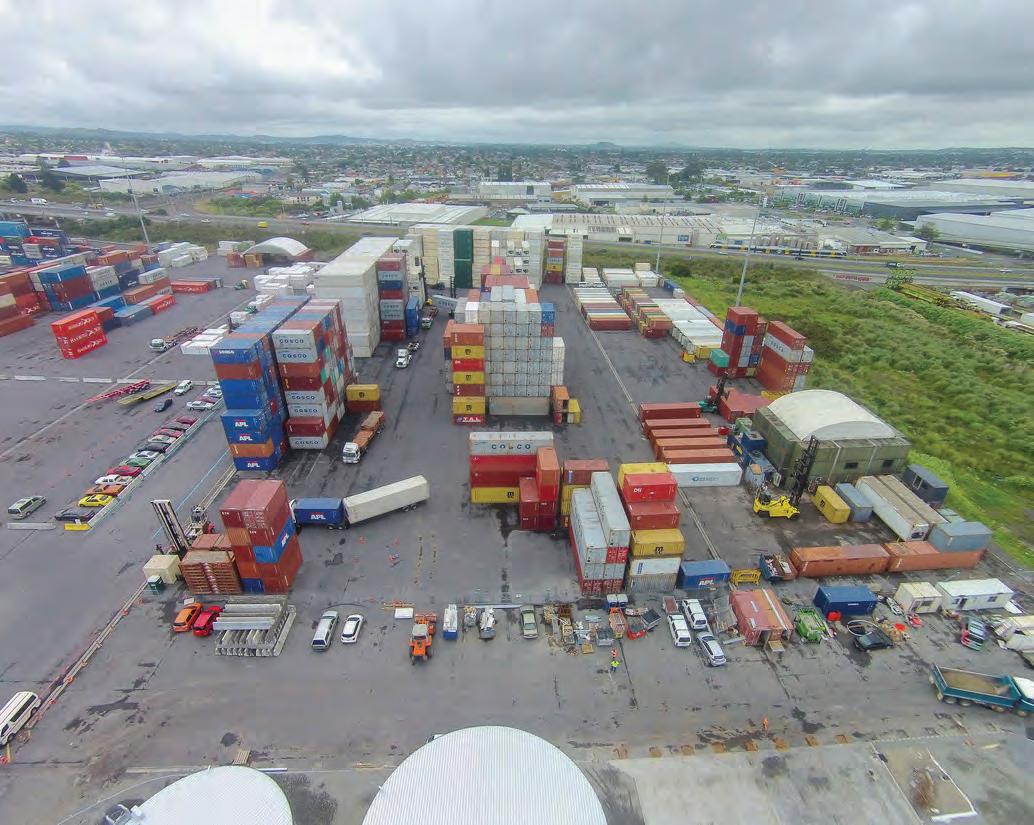
6 minute read
The trillion-dollar supply chain question
by CILTNZ
Dr Margaret Harris says there is an imbalance of boxes in New Zealand as ContainerCo can’t match what they require. For example, New Zealand needs a lot of refrigerated boxes but the country imports mostly plastic in dry boxes. Photos: ContainerCo
BY JAMES PAUL
THERE IS A PINCH in New Zealand’s supply chain; the locales storing containers are full, containers aren’t being taken away, and the containers the country needs are not landing. So says current CILT NZ Vice President Dr Margaret Harris, who is also ContainerCo Manager - Strategy and Innovation. It is a situation befalling many ports and freighting companies, she adds. According to the Ministry of Foreign Affairs and Trade’s (MFAT) October 2020 report – Monitoring the Operation of International Supply Chains – there is a reported fall in imports of nearly $1 billion in August, which led to the largest annual trade surplus since 2014. The report states that the $1.3 billion annual goods trade surplus was the result of a rise in exports, particularly of kiwifruit and dairy products, and a decline in imports during the national lockdown, notably of crude oil, cars and other vehicles.
While COVID-19 has disrupted global sea freight to a lesser extent than air freight, some sea freight supply chain pressures have emerged recently. Several industry stakeholders have reported sea freight import and export delays with vessels arriving five to seven days late to New Zealand.
This may have flow on delays for exporters to move goods offshore, according to MFAT. The delays have been attributed to multiple causes including deferred import activity from earlier in the year due to COVID-19 shutdowns in trading partners, the death of a worker at the Port of Auckland, and industrial action in Australian ports delaying vessel flows.
“These developments are occurring at a time when New Zealand typically enters peak import and export season and an intergovernmental group of officials led by the Ministry of Transport [MOT] is following developments closely,” the report states. What does this mean for companies like ContainerCo on the ground? Dr Harris says they’ve “got way too many containers”. The company stores, repairs, accepts and releases containers on behalf of major shipping lines, and this year has been the perfect storm in terms of disrupting various parts of the supply chain. According to Dr Harris, containers are arriving in New Zealand filled with plastic and finished goods. The company then readies them to export food, mostly milk powder and other food products. Therefore, there is an imbalance of boxes in the country as the company can’t match what they require. For example, New Zealand needs a lot of refrigerated boxes but the country imports mostly plastic in dry boxes. “What usually happens is the shipping company often has a few extra spots on the ship, and they pick up what they call evacuation boxes. They take a bunch of boxes that they don’t need away, and drop off a bunch of boxes that can be used which we fill up – matching the loads.” Not only is this a mix and match problem in New Zealand, but one experienced around the world, Dr Harris says. “The real problem is that when COVID-19 hit, the shipping companies assumed that global
demand would fall because there would be a recession. To be fair to them, that is what happened in the initial stages of the early lockdown, and the economy kind of tanked all over the world.
“The shipping companies accelerated their retirement scheme for some of their older vessels and cut routes, doing all sorts of things that are very sensible in a crisis of that kind. But the thing was, people who were trapped in their houses, looked at their kitchens and realised they hated it. “They had all this extra money because they weren’t eating out at restaurants, and hired a kitchen designer, and everyone renovated their kitchen at once. Suddenly demand for all those products boomed and needed to come from overseas.”
There were constraints, however, as shipping rates “went through the roof”, which Dr Harris puts down to the various complex factors involved.

She says if you’ve got an empty slot on a boat, the shipping company has the option of either taking an empty container – which isn’t going to make them money – or they can take a box which can. Therefore, the shipping companies, says Dr Harris, have been prioritising full boxes over the empties being evacuated from New Zealand.
That has led to hundreds of containers being trapped inside New Zealand and choking up the system, as there is only a limited capacity to hold all of them.
“We’re at 130% capacity in one of our yards in Auckland and 240% in another. We got to that level of capacity asking our neighbours if we could stack our containers on their land, which they kindly agreed to,” Dr Harris says. “We process all these containers in a batch. So, how we get above 100% is cutting into our working space, and the batches become smaller. Therefore, the container supply – the repair and upgrade – becomes much more constrained because you can’t make so many containers available per hour. “It’s a really tricky problem for us, which we’re managing as best we can. My staff and colleagues are amazing.” Luckily, MOT has been cognisant of the problem, and Dr Harris applauds their strength of conviction to try and fix the problems. “I think the lockdown taught them an awful lot about the supply chain in an awfully short space of time. And now they understand how it all fits together, they can see what levers to pull, which is really fascinating. They’re bloody clever.” “I would say that the quality of MOT policy that results from this fiasco will improve greatly. I mean, the quality of the policy was already excellent, let’s not get ourselves wrong. “But I just think the level of their understanding has taken a quantum leap in maybe the last year. The fact that these guys are ringing us up and telling us they understand what the problems are and asking how they can work with us to fix it, is not different from the norm but very encouraging.” As for the supply chain’s pinch being relinquished anytime soon, Dr Harris isn’t sure or confident. She can’t say if the supply chain will get better or worse, because COVID-19 is such a complex and evolving situation.

Hundreds of containers are trapped inside New Zealand and choking up the system, as there is only a limited capacity to hold all of them.
The pandemic provided all the right ingredients for the disruption of various parts of New Zealand’s supply chain.
“But I would say if it’s going to get better, it’ll get better over the wintertime because we import and export less during the winter.
“If we export less during the winter, we should be able to remove some of the excess containers from the system using the slots that come free on the ship. “But potentially, the ships might not call into New Zealand because they’ll be desperately needed elsewhere, between China and America, China and Europe. These ships might just be re-routed and we won’t have so many call, and I'm a bit worried about that.”







